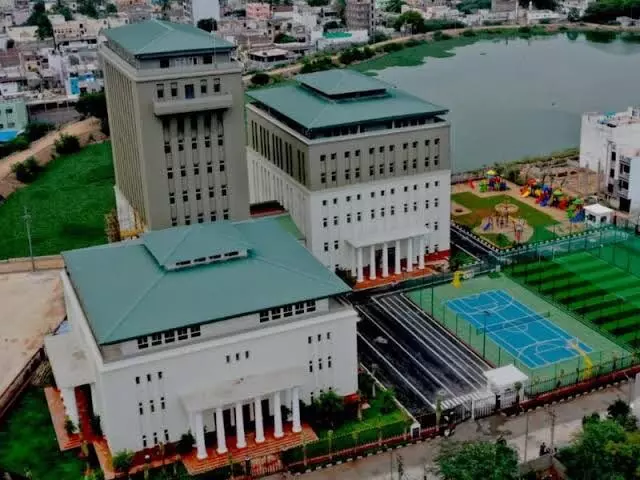HYDRAA set to demolish Fatima Owaisi campus after final notification
Ranganath explained that the delay in action was intentional to avoid future complications
By Sistla Dakshina Murthy
HYDRAA set to demolish Fatima Owaisi campus after final notification
Hyderabad: The Hyderabad Disaster Response and Asset Protection Agency (HYDRAA) will move ahead with the demolition of the Fatima Owaisi Educational Campus built on the Salkam Cheruvu tank bed in Chandrayangutta once the final notification and full tank level (FTL) verification are complete.
The decision was confirmed by HYDRAA Commissioner AV Ranganath during a ‘Meet the Press’ programme held on Saturday.
Demolition delayed over legal concerns
Ranganath explained that the delay in action was intentional to avoid future complications.
“HYDRAA is carefully examining all aspects before demolition to ensure there are no legal hurdles. In December 2016, a preliminary notification was issued for Salkam Cheruvu, but the final notification was never given. Nearly 80% of the city’s 900 lakes are in a similar situation,” he pointed out.
On the controversy surrounding Fatima Owaisi College, he clarified that HYDRAA follows a uniform policy across all cases, whether in Old City or Medchal. “Law is equal for all; final action depends on boundary notifications,” he said.
HYDRAA works with a century-long vision for Hyderabad
"HYDRAA is working with a 100-year master plan to secure the city’s future, rather than restricting itself to short-term goals," said AV Ranganath.
Long-term planning, not short-term gains
“HYDRAA is not here for one or two years; our vision is for the next hundred years,” the Commissioner said. He added that while there were initial misconceptions about HYDRAA’s role, people are now witnessing results.
In its first year, HYDRAA has safeguarded 500 acres of government land worth over ₹30,000 crore, protected hundreds of parks, and restored layouts to benefit common citizens. The authority has also prioritised the revival of lakes and stormwater channels to prevent urban flooding.
Focus on environmental protection
HYDRAA has placed strong emphasis on ecological balance and public health. “Food and water in Hyderabad have been found to contain harmful chemicals. We must restore our lakes to secure clean water and healthier surroundings,” Ranganath said.
The restoration of Bathukamma Kunta in Amberpet and Nallakunta Lake in Kukatpally stand as examples of successful projects. Soon, Uppal Nalla Cheruvu, Bum-Rukn-ud-Dowla in Old City, Sunnam Cheruvu in Madhapur, and Thammidikunta will be ready for public access. A second phase covering 13 more lakes is also planned.
HYDRAA beyond politics
Emphasising HYDRAA’s neutrality, the Commissioner said, “Our work is above caste, religion, or political influence.” He pointed out how political encroachments at Gandipet lake were cleared, and added that boundary demarcation of Himayat Sagar is still pending.
Lakes turning into public spaces
Rejuvenated lakes are fast becoming popular recreational hubs. “Today, people are flocking to Bathukamma Kunta and Nalla Cheruvu to relax and spend time with families. This is how Hyderabad will transform into a greener and more beautiful city,” Ranganath said.
HYDRAA is also preparing to restore the 55 km-long Balkapur Nala, which drains into Hussainsagar, and will soon hold consultations with residents along its stretch.
Backed by government, working with departments
Ranganath credited the state government for giving HYDRAA both authority and freedom to act decisively. Recently, Chief Minister Revanth Reddy inspected flood-prone areas in Ameerpet and directed immediate measures.
HYDRAA, in coordination with GHMC and Irrigation officials, is working on solutions like expanding the lake in Krishna Kanth Park to hold excess rainwater and reduce inundation in Ameerpet.
Improving weather forecasting
Hyderabad’s rapidly changing microclimate poses challenges for weather prediction. “Unlike Europe, India has diverse patterns even within a city. To improve accuracy, we need more automatic weather stations,” Ranganath said.
HYDRAA is working with the Meteorological Department and has studied models in Karnataka. Alongside forecasting improvements, it is also promoting rainwater harvesting. “At present, 98% of rainwater drains away; only 2% seeps into the ground. We will reverse this trend with percolation pits,” he explained.
Towards a resilient and livable city
Commissioner Ranganath concluded that HYDRAA’s scientific approach, political neutrality, and long-term planning will help build a flood-resistant, environmentally sustainable, and people-friendly Hyderabad in the coming years.